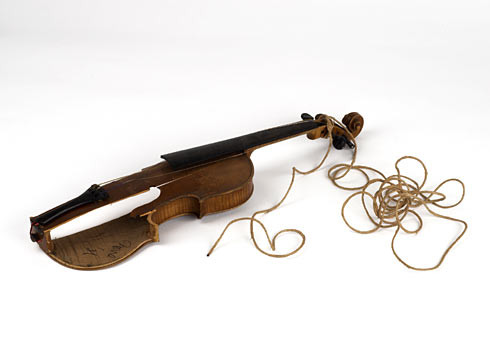Nam June Paik
13 Feb - 17 May 2009

© Nam June Paik
Violin with String, 1961
Violin, string
MUMOK (former Hahn Collection, Cologne)
Photo: MUMOK, Lisa Rastl, © Estate of Nam June Paik
Violin with String, 1961
Violin, string
MUMOK (former Hahn Collection, Cologne)
Photo: MUMOK, Lisa Rastl, © Estate of Nam June Paik
NAM JUNE PAIK
"Music for all Senses"
13 February - 17 May 2009
Opening: February 12, 2009–7.00 p.m.
In 1963, with his first individual show ‘Exposition of Music – Electronic Television’ at the legendary Galerie Parnass in Wuppertal, Germany, the young Nam June Paik literally created a new genre of exhibition. The visitors, who were greeted in front of the entrance with a freshly slaughtered ox head, were not only confronted with the newness of the electronic image, but also found themselves integrated into a Dadaist scenario staged with prepared pianos, mechanical sound objects along with record players and audio tape installations. With the first modified television, the exhibition marked the beginning of video art. The museum possesses the largest collection of Paik’s early works all from this exhibition, with the only surviving piano the Klavier Integral and the work for television Zen for TV. Together with documents, photographs and audio installations, the exhibition at MUMOK will recreate scenes from the original show, letting the works again come to life in their original context.
Curator
Susanne Neuburger
"Music for all Senses"
13 February - 17 May 2009
Opening: February 12, 2009–7.00 p.m.
In 1963, with his first individual show ‘Exposition of Music – Electronic Television’ at the legendary Galerie Parnass in Wuppertal, Germany, the young Nam June Paik literally created a new genre of exhibition. The visitors, who were greeted in front of the entrance with a freshly slaughtered ox head, were not only confronted with the newness of the electronic image, but also found themselves integrated into a Dadaist scenario staged with prepared pianos, mechanical sound objects along with record players and audio tape installations. With the first modified television, the exhibition marked the beginning of video art. The museum possesses the largest collection of Paik’s early works all from this exhibition, with the only surviving piano the Klavier Integral and the work for television Zen for TV. Together with documents, photographs and audio installations, the exhibition at MUMOK will recreate scenes from the original show, letting the works again come to life in their original context.
Curator
Susanne Neuburger
